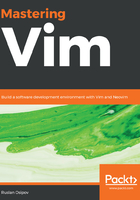
Plugin spotlight – NERDTree
NERDTree is a handy plugin that emulates modern IDE behavior by displaying a file tree in a split buffer to the side of the screen. NERDTree is available from https://github.com/scrooloose/nerdtree (see Installing Plugins earlier in this chapter for installation instructions).
Once installed, you can invoke NERDTree by typing the following:
:NERDTree
A list of files in a directory will show up:

Use h, j, k, and l or the arrow keys to navigate the file structure, and Enter or o to open the file. There are multiple useful shortcuts, and Shift + ? brings up a handy cheat sheet.
A notable feature is bookmark support, which allows you to bookmark a directory (when placing the cursor over it in NERDTree) by executing :Bookmark. Press B when in a NERDTree window to display bookmarks at the top of the window.
In the following screenshot, you can see the bookmarks I have for code that supports chapters of this book (the Chapter01/ and Chapter02/ directories):

You can choose to always display bookmarks in a NERDTree window by setting the NERDTreeShowBookmarks option in your .vimrc file:
let NERDTreeShowBookmarks = 1 " Display bookmarks on startup.
You can bring NERDTree up or hide it by executing :NERDTreeToggle. If you're interested in having NERDTree up every time you're editing, you might want to add the following to your .vimrc file:
autocmd VimEnter * NERDTree " Enable NERDTree on Vim startup.
Something I personally found really useful is to close the NERDTree window automatically when it's the last open window. I have the following in my .vimrc file:
" Autoclose NERDTree if it's the only open window left.
autocmd bufenter * if (winnr("$") == 1 && exists("b:NERDTree") &&
\ b:NERDTree.isTabTree()) | q | endif
These days, I rarely find myself using NERDTree. Before switching to Vim, I often relied on having a project outline in the view when I worked. In my early days of learning Vim, NERDTree was a lifesaver. Vim changed the way I work and having a file outline always on became distracting, so eventually I moved back to using Netrw.